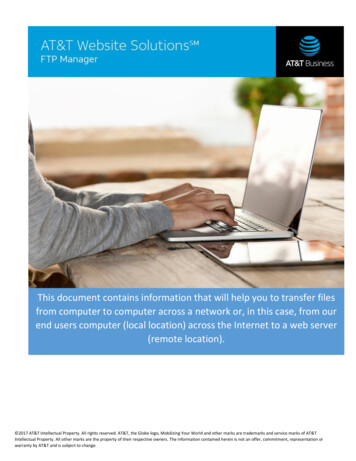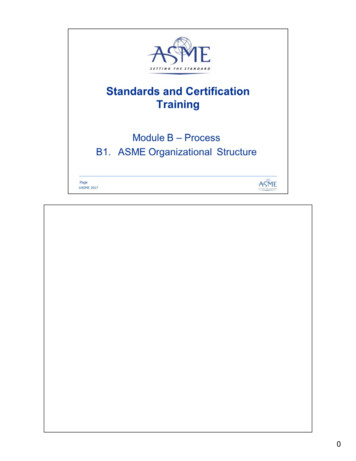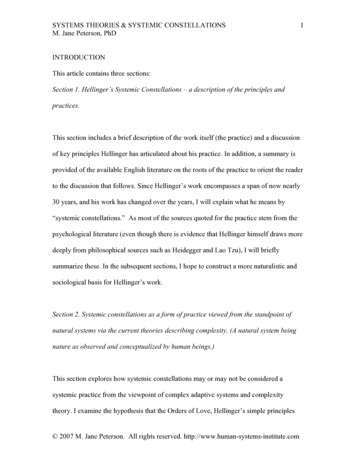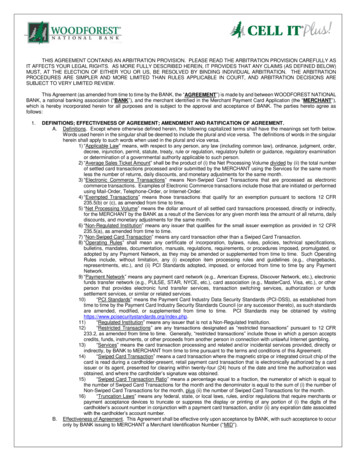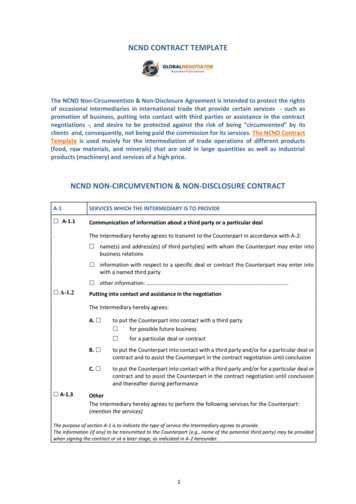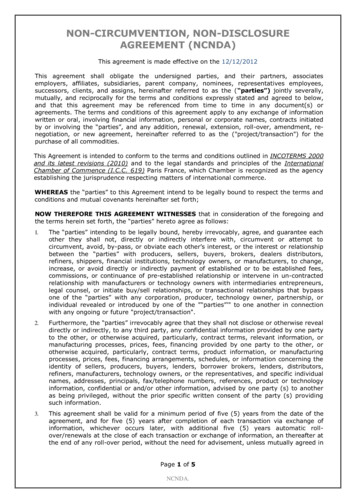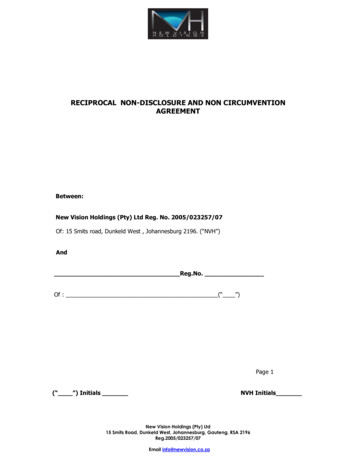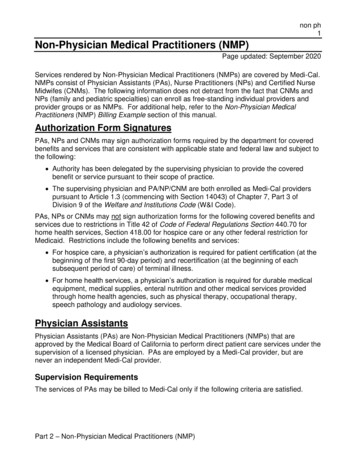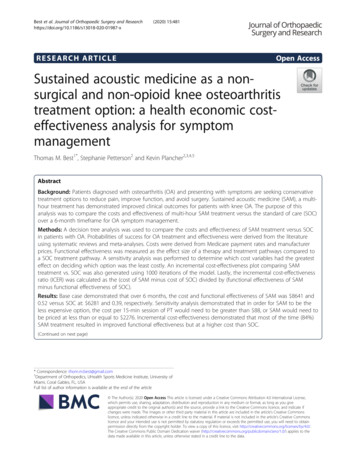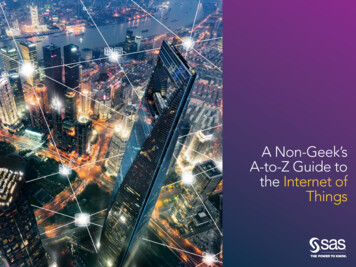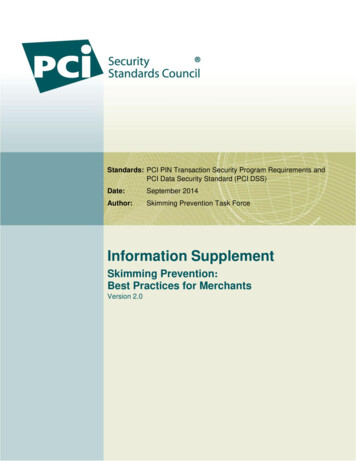
Transcription
Standards: PCI PIN Transaction Security Program Requirements andPCI Data Security Standard (PCI DSS)Date:September 2014Author:Skimming Prevention Task ForceInformation SupplementSkimming Prevention:Best Practices for MerchantsVersion 2.0
Information Supplement Skimming Prevention: Best Practices for Merchants September2014Table of ContentsChapter 1: Overview . 3About This Document . 4What is Card Skimming and Who Does It? . 4Data from Consumer Payment Cards . 4Data Capture from the Payment Infrastructure. 4Data Capture from Malware or Compromised Software . 5Data Capture from Wireless Interfaces . 5Data Capture from NFC or Contactless Readers . 5Data Capture from Mobile Devices . 5Data Capture from Overlays . 6Perpetrators and Targets . 6The Impact of Skimming Attacks . 8Card-Issuers and Payment Networks . 8Merchants . 8Consumers . 9Examples of Terminal Fraud. 9Chapter 2: Guidelines and Best Practices . 17Merchant Physical Location and Security .17Threat-Mitigating Resources . 18Physical Protections . 18Terminals and Terminal Infrastructure Security .20Terminal Surroundings . 21IP Connectivity . 21Individual Terminal Data . 22Terminal Reviews . 22Terminal Purchases and Updates . 23Terminal Disposal . 23PIN Protection . 24Wireless Terminals . 24Staff and Service Access to Payment Devices .25Staff as Targets . 26Hiring and Staff Awareness . 26Outside Personnel and Service Providers . 27Risk Analysis of Terminals and Terminal Infrastructure .28The intent of this document is to provide supplemental information. Information provided here does notreplace or supersede PCI security standards and requirements.1
Information Supplement Skimming Prevention: Best Practices for Merchants September2014Identification of Assets . 28Threat and Probability. 28Severity . 28Additional Resources.29PCI SSC YouTube Channel . 29Australian Payments Clearing Association . 29VeriFone . 29Interac.org . 29Appendix A: Risk Assessment . 30Risk Assessment Questionnaire .30Risk Category .33Appendix B: Evaluation Forms . 34Terminal Characteristics Form.34Merchant Evaluation Checklist .35The intent of this document is to provide supplemental information. Information provided here does notreplace or supersede PCI security standards and requirements.2
Information Supplement Skimming Prevention: Best Practices for Merchants September2014Chapter 1: OverviewThe primary mission of the Payment Card Industry Security Standards Council (PCI SSC) is to ensurethe security of payment data and the security of the payment infrastructure that processes that data.PCI SSC is committed to build trust in the payment process and payment infrastructure for the benefitof all constituents. As the threats and vulnerabilities of fraud evolve, payment constituents can andshould expect the emergence of further security standards and requirements for terminal types,terminal infrastructures, payment devices, and payment processes.This document was created to assist and educate merchants regarding security best practicesassociated with skimming attacks. Though currently not mandated by PCI SSC, guidelines and bestpractices documents are produced to help educate and create awareness of challenges faced by thepayment industry. The guidelines are the result of industry and law enforcement understanding of thecurrent and evolving threat landscape associated with skimming. In addition we have incorporatedknown best practices, currently conducted by many merchants, to mitigate skimming attacks takingplace in their respective point-of-sale environments.This document contains a non-exhaustive list of security guidelines that can help merchants to: Be aware of the risks relating to skimming - both physical and logical. Be aware of the vulnerabilities inherent in the use of point-of-sale terminals and terminalinfrastructures. Be aware of the vulnerabilities associated with staff that has access to consumer paymentdevices. Prevent or deter criminal attacks against point-of-sale terminals and terminal infrastructures. Identify any compromised terminals as soon as possible and notify the appropriate agencies torespond and minimize the impact of a successful attack.Additional security can—and must—be provided by merchants to enhance the security provided bypayment-terminal vendors and adherence to the current PCI SSC standards. With enough time andresources, any device can fall victim to physical or logical attacks. Limiting the time the device isunattended or unchecked reduces the effectiveness of an attack should an attempt be made againstthe device. Merchants have an obligation to ensure their respective payment systems andinfrastructures are secure. Merchants are the first line of defense for POS fraud and are involved in theexecution of the vast majority of controls suggested or required by PCI SSC. Merchants can achieveappropriate security and trust levels at the point of sale by considering all the factors that can influenceoverall security in their terminal environments and by taking the necessary countermeasures detailed inthis document to ensure an appropriate level of security.The intent of this document is to provide supplemental information. Information provided here does notreplace or supersede PCI security standards and requirements.3
Information Supplement Skimming Prevention: Best Practices for Merchants September2014About This DocumentThis document consists of the following: Chapter 1 provides a general overview; describes exactly what card skimming is, who does it,and how it impacts the various payment constituents; and provides some real-life examples ofcompromised terminals. Chapter 2 provides an extensive list of best practices and guidelines merchants need toconsider if they have not done so already. The list identifies threats and challenges and possibleremedies merchants can take to mitigate the risk of being victims of skimming attacks. Appendix A provides a mechanism for the merchant to further quantify risk associated withmerchant location and terminal infrastructure. Appendix B provides a checklist merchants can use to identify and track terminal assets.What is Card Skimming and Who Does It?Skimming is the unauthorized capture and transfer of payment data to another source for fraudulentpurposes. This unauthorized capture and transfer of payment data is different than mass datacompromise breaches, and can result from one of the event types listed below.Data from Consumer Payment CardsThe first type of skimming event is the acquisition of payment data directly from the consumer’spayment device (payment card). This is normally accomplished through a small, portable cardreader and usually involves internal merchant personnel who have both criminal intent and directaccess to the consumer payment device. The majority of skimming attacks deal with the captureof payment data from magnetic-stripe payment cards outside of the payment terminal when thepayment card is handled by the merchant personnel and when the consumer has little or noobservation at the time of payment. Skimming chip cards has also become increasingly popular,and many chip cards also have magnetic-stripes.Data Capture from the Payment InfrastructureThe second type of skimming event results from the capture of payment data within the paymentinfrastructure at the merchant location, with a focus on compromised POS terminals and theirrespective infrastructures (terminal locations, wires, communication channels, switches, etc.).Criminals will insert electronic equipment, by various means, into the terminal or the terminalinfrastructure, in order to capture consumer account data. The skimming equipment can be verysophisticated, small, and difficult to identify. Often it is hidden within the terminal so neither themerchant nor the cardholder knows that the terminal has been compromised.The intent of this document is to provide supplemental information. Information provided here does notreplace or supersede PCI security standards and requirements.4
Information Supplement Skimming Prevention: Best Practices for Merchants September2014Data Capture from Malware or Compromised SoftwareAnother type of skimming event results from the capture of payment data from malicious softwareor memory scrapers. In this attack, poorly coded software allows for malware or malicious code tobe loaded on the device. This code may intercept and capture payment card information (bothmagnetic-stripe and/or chip data) as well as PIN information. The information is then sent toanother location for retrieval. This type of activity is largely seen in devices that provide functionsother than payment processing. These include ATMs, PCs that have access to card data,electronic cash registers (ECRs), computer-based POS systems, mobile devices (includingtablets and smart phones), and more recently, compromised terminals.Data Capture from Wireless InterfacesSkimming can occur from the interception of payment data across a wireless infrastructure.Wireless networking technologies such as Bluetooth and Wi-Fi allow information to be transmittedacross the public airwaves between devices. Poor Bluetooth pairing techniques, lack ofencryption, as well as shared or inadequately secured Wi-Fi implementations can allow data to beintercepted and the data network to be compromised. More information can be found in the PCIWireless Guidance information supplement at:https://www.pcisecuritystandards.org/pdfs/PCI DSS v2 Wireless Guidelines.pdfData Capture from NFC or Contactless ReadersAs with data from consumer cards, use of NFC (near field communication) or contactless readerscan result in the skimming of the payment information. The NFC data is sent in close proximity toan NFC reader across the airwaves. This information can be intercepted should another NFCreader, such as a capable mobile device or contactless reader, be placed near the paymentacceptance device. In addition, some NFC readers are added on as an aftermarket update andmay not have been tested with the terminal or POS device.Data Capture from Mobile DevicesIn this type of attack, a modified card reader (skimmer) is attached to the headphone jack of thecriminal’s smartphone or tablet. The smartphone then displays a fake prompt to have theconsumer enter their PIN directly on the smartphone, thus capturing both the card account dataand the associated PIN. PINs must only be entered on PCI PTS approved devices. Refer to thePCI guide “Accepting Mobile Payments on Smartphones at urity standards/documents.phpThe intent of this document is to provide supplemental information. Information provided here does notreplace or supersede PCI security standards and requirements.5
Information Supplement Skimming Prevention: Best Practices for Merchants September2014Data Capture from OverlaysOverlay attacks have traditionally been used in ATMs or other unattended devices to capture cardaccount and PIN data. (See Image 16 in “Examples of Terminal Fraud” below.) In these types ofattacks, an overlay that contains wires or an additional card reader is placed on the ATM or POSterminal. A sticker overlay may be added to the keyboard area to capture the PIN, (Image 12); or,using a 3D printer, a new casing maybe placed over the existing device (Image 13). Theseoverlays can hide tamper evidence, add an additional reader, and slightly change the operationand look of the terminal.Perpetrators and TargetsUnderstanding the lengths that criminals go to in order to obtain and compromise account datamay help you understand the necessity of taking sufficient measures to make it significantly moredifficult for the criminals to target your particular location.Who Does It?Regardless of how it is achieved, skimming is a highly profitable criminal activity, difficult toprevent and detect. As a result, it appeals to both ends of the criminal spectrum: The most sophisticated and dedicated organized criminal elements, leading to verycomplex and surprisingly effective attacks on merchant terminal infrastructures; and The most common, least sophisticated of criminal elements, using readily available,simple technology and direct access to ATMs, POS devices, and consumer paymentcards.Criminals want a high and rapid rate of return, regardless of the type of theft they areconsidering. Skimming allows them to capture massive amounts of account details in a shortamount of time, with low risk of detection. As a result, skimming often is their first and foremostconsideration. With globalization and the Internet, underground industries have evolved thatcan move and distribute large amounts of stolen information quickly and efficiently, maximizingthe profit to the criminals who may operate in safe havens anywhere in the world.TargetsPIN DataIn addition to the acquisition of account data on the card, criminals are very interested in theacquisition of PIN data. The industry and law enforcement have seen significant efforts toacquire PINs at the payment terminal by the following means, among others: “Shoulder-surfing” by individuals stationed near the ATM or POS device Placement of fake PIN entry devices (PEDs), ATMs, or readers and CCTV camerasdirected at the PIN entry area on the payment terminal Malware and memory scrapers in PIN entry devices (PEDs), ATMs, or readers.The intent of this document is to provide supplemental information. Information provided here does notreplace or supersede PCI security standards and requirements.6
Information Supplement Skimming Prevention: Best Practices for Merchants September2014ATMs, Unattended, or Temporarily Unattended TerminalsMerchant locations that for a wide variety of business needs have self-service terminals,ATMs, unattended payment terminals, exterior payment terminals, and/or multiple terminallocations that are not attended to all the time are prime targets for intrusive-terminal andterminal-infrastructure attacks.Criminals will also target large multi-lane retailers where, during less busy periods, not all ofthe lanes are used and terminals are effectively left unattended. Criminals will steal terminalsand compromise them, then return them to either the same store or to another store in thesame chain.There have been many cases where criminals have: Stolen terminals from cash lanes and desks not in use. Broken into a store and taken only the terminals. Broken into a store and compromised the terminals. Hidden themselves in the store until it closed and compromised the terminals overnight,leaving when the store re-opened. Swapped a good terminal for a compromised terminal, using large items to blockattendants’ line of sight. Swapped good terminals for compromised terminals or installed malware while posingas a service technician. Added overlays with skimming and key-logging hardware. Shipped compromised terminals to merchants under the guise of a terminal upgrade andrequired the good terminals to be returned to the criminal. Installed malware or automated software called bots that
infrastructure at the merchant location, with a focus on compromised POS terminals and their respective infrastructures (terminal locations, wires, communication channels, switches, etc.). Criminals will insert electronic equip
